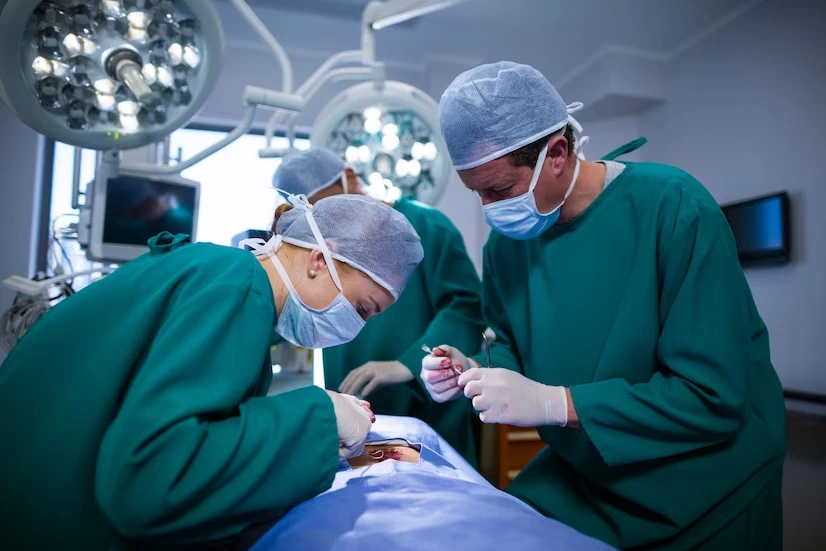Internal hernias are hernia versions that occur in rare. The protrusion of the abdomen content causes them, often bowel or intestine loops that pass through the abdominal tissue wall.
Internal hernias are not visible on the outside and are caused due to birth defects, trauma, or intra-abdominal pressure. They are often found via examining medical history, physical examination, and imaging tests.
Internal hernias do not require any surgical intervention in case of minor disturbance. In severe scenarios, minimally invasive surgeries and open surgery options are available.
Table of Contents
ToggleWhat are the Main types of Internal Hernias?
The main kinds of internal hernias include:
- Paraduodenal Hernia
- Foramen of Winslow Hernia
- Transmesenteric Hernia
- Transomental Hernia
- Intersigmoid Hernia
- Pericecal Hernia
- Retroanastomotic Hernia
Paraduodenal Hernia
Paraduodenal hernias are the most common internal hernias. It is caused by the small intestine protruding into the paraduodenal fossa. The paraduodenal fossa is the abdominal space at the back of the duodenum (a section of the small intestine).
Herniation into the paraduodenal fossa is often caused by a defective or weak spot in the mesentery (the tissue that supports the intestines by attaching it to the back wall of the abdomen).
Paraduodenal hernias are usually congenital due to the failure of the intestines to rotate completely during fetal development.
There are two kinds of paraduodenal hernia: the left paraduodenal hernia and the right paraduodenal hernia. Most often the hernia appears in the left paraduodenal fossa (fossa of Landzert) than in the right paraduodenal fossa (fossa of Waldeyer).
Paraduodenal hernias are identified through nausea, vomiting, constipation, and intestinal obstruction. Imaging tests are employed at times as paraduodenal hernias are difficult to diagnose.
Open or laparoscopic surgery can be used to treat paraduodenal hernias. The choice of surgery depends upon the severity of the paraduodenal hernia.
Foramen of Winslow Hernia
The foramen of Winslow is the opening or passage between the greater peritoneal cavity and the lesser sac (the space between the stomach and the pancreas). When the abdominal contents herniate to the foramen of Winslow, it is called the foramen of Winslow hernia or the lesser sac hernia.
An enlarged foramen of Winslow or abnormal development of the intestines during fetal development can cause the foramen of Winslow hernia.
The foramen of Winslow hernia is rare but poses the risk of obstructing the bowel. Obstruction of the foramen of Winslow hernia causes pain, nausea, vomiting, or constipation. The foramen of Winslow hernia is diagnosed through imaging tests and treated via laparoscopy or open surgery.
Transmesenteric Hernia
Mesentery is a membrane that helps the intestines to attach to the abdominal wall. In transmesenteric hernia, the small intestine herniates through a weak spot in the mesentery.
Transmesenteric hernia can be congenital or developed later in life due to abdominal injury, inflammation of the mesentery, or a previous surgical accident.
The transmesenteric hernia causes pain around the upper part of the central abdominal region and the umbilical region. When the transmesenteric hernia gets complicated, nausea, vomiting, and intestinal obstruction problems also arise. Open or minimally invasive surgeries are employed to treat transmesenteric hernia based on its severity.
Transomental Hernia
Transomental hernia occurs when the small intestine herniates through the omentum. The omentum is a fatty tissue that fills the abdominal cavity and lies over the organs of the abdomen.
This hernia often strangulates the small intestine and requires immediate surgical intervention.
Transomental hernia occurs due to birth defects, abdominal inflammation, trauma, or surgical exploration.
Constipation may accompany nausea and vomiting in case the hernia gets complicated, and open or laparoscopic surgery may be employed to repair it.
Intersigmoid Hernias
Intersigmoid hernias occur when the small intestine or other abdominal content herniates through the intersigmoid fossa. The inter-sigmoid fossa is the peritoneal cavity between the sigmoid colon and the mesentery.
Intersigmoid hernias are rare and can be identified through pain in the abdominal and flank regions. Complicated intersigmoid hernias cause vomiting, nausea, constipation, and abdominal pain. Laparoscopic surgery is widely employed to treat inter-sigmoid hernia. Open surgery is also employed when necessary.
Pericecal Hernias
Pericecal hernias are also known as paracecal hernias, ileocolic hernias, retrocecal hernias, or ileocecal hernias.
Pericecal hernias arise due to defects in the cecal mesentery and herniation of the abdominal content to the pericecal fossa. It is a rare internal hernia.
Pericecal hernia is often misunderstood as appendicitis. It is characterized by severe pain in the lower abdomen and obstructs the small intestine. It can be diagnosed through barium swallow or imaging tests, and open or laparoscopic surgery is employed to repair it.
Retroanastomotic Hernias
Retroanastomotic hernias are rare but highly fatal. They occur due to the defective retro anastomotic space post a retro colic anastomosis or surgery. Retrocolic anastomosis leaves a space in the mesentery that gives space for the bowels to herniate and give rise to retroanastomotic hernias.
Retroanastomotic hernias are characterized by severe pain in the abdomen, constipation, nausea, and vomiting and demand immediate medical attention.
Conclusion
Internal hernias are rare hernias and are challenging to the diagnosing surgeon. Often internal hernias get noticed only when the complicated situation escalates.
Imaging tests and other physical examinations are employed to identify internal hernias, and they require the skilled eye of an experienced hernia surgeon to diagnose and operate on them.
To know more about internal hernias and how to treat them, contact a hernia specialist.
Dr. K. Amilthan MBBS., MS., FMAS., FALS.
Heal Your Hernia Now:
- 20+ Years of Experience
- 1,000+ Surgeries
Your Journey to Wellness Begins with us.
FAQ's
Yes, internal hernias are curable. Some internal hernias are manageable without surgery, while others are repaired through surgery to prevent complications. You can take enough fluids and bowel rest to prevent an internal hernia from getting severe.
The recovery from an internal hernia surgery is based on the surgery employed. Minimally invasive surgeries enable you to resume work within 1 or 2 days. Open and major surgeries may require more than three weeks for recovery.
Yes, you can live with an internal hernia without surgery as long as it does not get complicated. A complicated hernia can turn fatal. So, ensure that your hernia is manageable without surgery and take the necessary steps to prevent strangulation, obstruction, or incarceration of the internal hernia.

Dr. Amilthan
Dr. Amilthan is a renowned laparoscopic hernia surgeon based in Chennai, with over 20 years of experience in general surgery. He completed his MBBS and MS in General Surgery at Kilpauk Medical College and Government Royapettah Hospital in Chennai.
- All Posts
- Hernia Blog

Which Doctor should you consult for Hernia? You can Consult a general surgeon or a hernia specialist for evaluation and...

A hernia occurs when an organ or any other part of your body pushes through the muscle and surrounding tissue...

An inguinal hernia occurs when the organs push through and bulge against the weak muscles of the abdomen. An effective...

